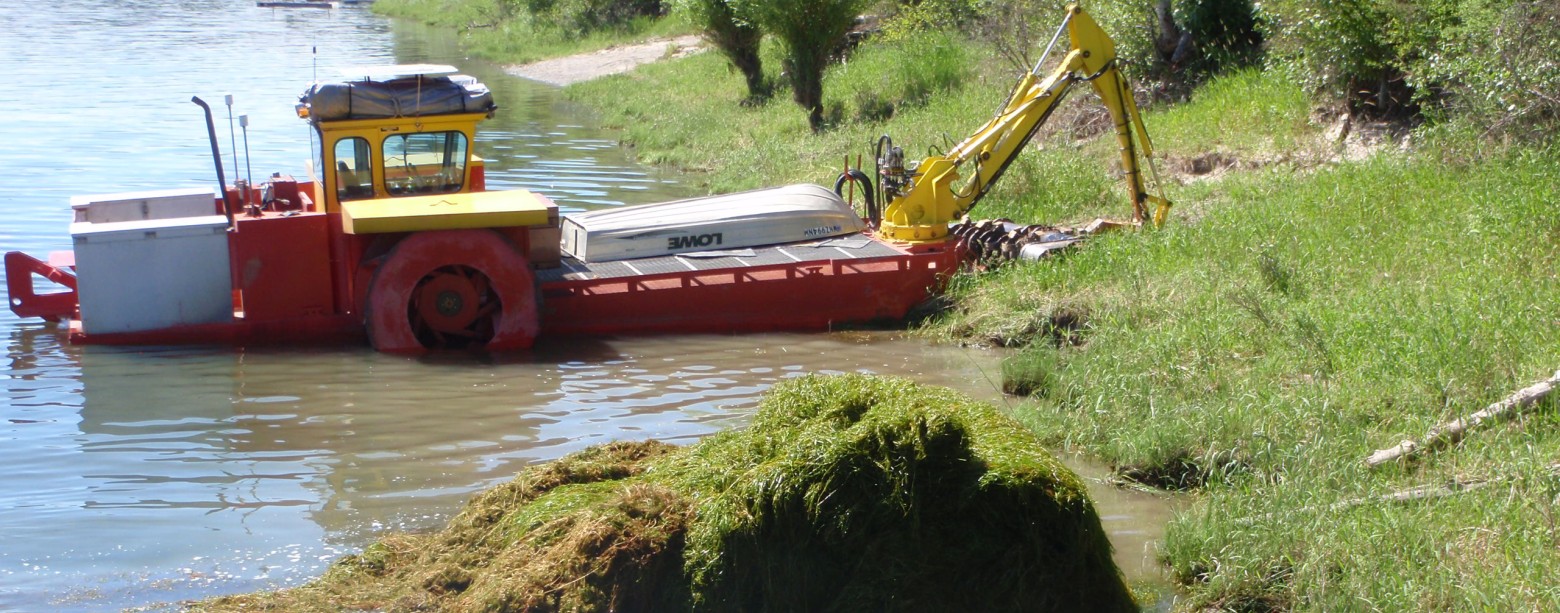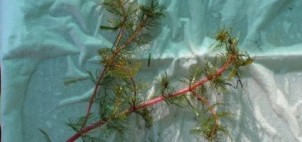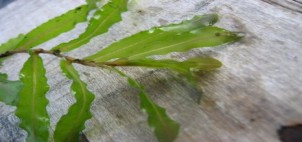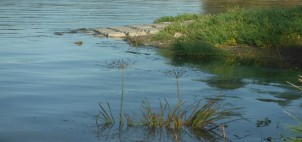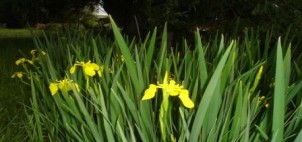Working to Remove Nuisance Plants Impacting our Area
Aquatic Weed Control is referred to in many different ways in our area including: Milfoil control, Aquatic Plant Management, Noxious water weed removal, or Seaweed control. Regardless of what you call it, this work is focused on removing or suppressing hazardous or nuisance plants that have a negative impact on habitat, recreation, and public safety in or around the Pend Oreille River.
There are over 22 different types of aquatic plants in the river, but only 4 are noxious weeds: Eurasian Watermilfoil, Curly-leaf Pondweed, Yellow Flag Iris, and Flowering rush. When combined, all 4 noxious weeds make up less than 30% of the plants you see when you travel down the river. The remaining 18 are native plants that provide a number of benefits in our river, such as: binding excess nutrients which reduces the frequency and severity of algae blooms later in the summer; they are an excellent source of oxygen, cover, and food for fish and other aquatic life; they reduce shoreline erosion by dampening wave energy before hitting shore; and like a good lawn, a dense cover of native plants makes it more difficult for noxious weeds to take over your shoreline.
As part of our Federal Energy Regulatory Commission (FERC) mandated requirements to operate Box Canyon Dam, the PUD works cooperatively with the Pend Oreille County Noxious Weed Control Board (PONWCB), The Kalispel Tribe of Indians, The USDA Forest Service , The Washington Department of Ecology, and several other state agencies to manage non-native aquatic plants in the Pend Oreille River from Albeni Falls Dam to Box Canyon Dam.
Program Goals
Our weed control program is focused on two primary goals:
- The first goal is to take actions to reduce the chance that Eurasian Water Milfoil (EWM) and other non-native aquatic plants (e.g., Curly Leaf Pondweed, Flowering Rush, and Yellow Flag Iris), will be transported to nearby lakes and rivers.
|
|
|
|
|
|
- The second goal is to increase public safety and enhance user experience at publicly accessible boat launches and swim areas in the Pend Oreille River.
What we do: Both Public and Private
To achieve these goals at high-use, publicly accessible sites, the PUD provides intensive mechanical aquatic plant removal at 23 different treatment areas in the Box Canyon Reservoir at multiple times throughout the year. The PUD also provides the public with aquatic plant management training, education, and support through grant programs and an annual summer aquatic weed workshop. These public outreach programs are designed to address management goals outside the treatment areas for private landowners and other river and shoreline users.
Boat Launch and Swim Area Treatment
The mechanical removal of vegetation at each treatment area is provided using two different treatment methods. First through Rotovation, operators remove the aquatic plant root mass (completed from fall through the winter months after vegetation has died back). Then, Harvesting follows by removing the remaining vegetation that grows near the surface during the summer months. A description of each boat launch treatment machine and how they work is found below.
Rotovator or Aquamog
The Rotovator
The Rotovator 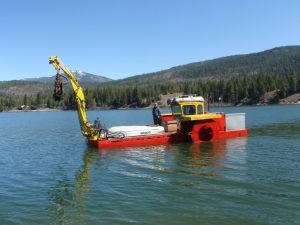 uses a rotating barbed spool to wind up the EWM and pull the plant roots. When collected, the machine deposits the plant material on the shore above the waterline for removal and transport to an upland dump site. The Rotovator is operated as needed from fall through spring when river flows are below 40,000 cubic feet per second so the mechanical arm can reach deep rooted plants up to 18’ down. Follow this link to see a list of where treatment has or will occur. Typically the Rotovator operates in our treatment areas from October through April.
uses a rotating barbed spool to wind up the EWM and pull the plant roots. When collected, the machine deposits the plant material on the shore above the waterline for removal and transport to an upland dump site. The Rotovator is operated as needed from fall through spring when river flows are below 40,000 cubic feet per second so the mechanical arm can reach deep rooted plants up to 18’ down. Follow this link to see a list of where treatment has or will occur. Typically the Rotovator operates in our treatment areas from October through April.
The Aquatic Plant Harvester
The aquatic pla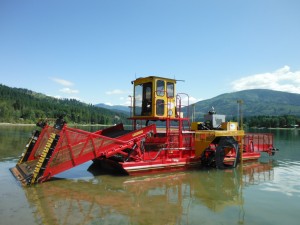 nt harvester (aquamog) uses a hydraulically lowered conveyor belt tipped by sickle bars on the sides and lower edge (shown below) to cut the aquatic plants off just above the roots. This machine then collects the suspended plant material with the conveyor belt for transport off-site. This machine can cut and collect plants up to 6 feet deep and transport 18,000 lbs. of aquatic vegetation per load. The harvester is most efficient after the spring flooding has receded and plant growth is about to reach the surface. Typically the harvester operates in our treatment areas from the middle of July to October. Follow this link to see a list of where treatment has or will occur.
nt harvester (aquamog) uses a hydraulically lowered conveyor belt tipped by sickle bars on the sides and lower edge (shown below) to cut the aquatic plants off just above the roots. This machine then collects the suspended plant material with the conveyor belt for transport off-site. This machine can cut and collect plants up to 6 feet deep and transport 18,000 lbs. of aquatic vegetation per load. The harvester is most efficient after the spring flooding has receded and plant growth is about to reach the surface. Typically the harvester operates in our treatment areas from the middle of July to October. Follow this link to see a list of where treatment has or will occur.
Protecting Water Quality While Managing Aquatic Plants
While the PUD is dedicated to managing aquatic plants in the Pend Oreille River, we also currently manage several community water systems that pull directly from Pend Oreille River, and therefore the District always strives to maintain or improve water quality in the river. The techniques we use to manage our treatment areas are mechanical or biological and do not use, nor does the PUD recommend use of, chemical herbicides at or below the waterline, which could reduce overall river water quality.
Support for Pend Oreille River Landowners
The PUD, in conjunction with the POCNWCB and several other contributors, sponsor an Annual Public Workshop where information on new aquatic plant management techniques, tools, and funding opportunities are presented. The focus of this workshop is on non-herbicide options that are sustainable and affordable for the public to use around private docks and launches. Guest speakers cover aquatic plant identification (how to tell noxious weeds from beneficial native plants), the benefits of healthy vegetation, and provide hands on demonstrations of a variety of tools available for homeowners. The workshop also explains the process and permits required by Washington State to manage aquatic weeds on private shorelines. Many different weed management contractors are available during the workshop to explain the services they provide on the river. At the Public Workshop:
- Attendees learn to identify different aquatic plants
- Attendees get to have hands on identification of aquatic plants.
- Attendees learn about the benefits of certain aquatic plants.
Get Help Managing Your Aquatic Weeds
The PUD has partnered with the POCNWCB to provide grant funding for aquatic plant management projects on the Pend Oreille River through the Neighborhood Cost Share Program. Grants are available each year to fund multiple projects on the river, with the goal of providing tools or services for non-herbicide aquatic plant treatment. Any project meeting the state’s requirements for a non-herbicide approach to aquatic plant management on the Pend Oreille River is eligible to receive up to $500 per individual or $1000 for group application. Grant funds can be used to pay for a wide variety of tools and services, and there is no requirement for matching funds in order to be eligible. For more information on how the grant program works and the application process, contact Loretta Nichols lnichols@pendoreille.org at the Pend Oreille County Weed Board.
Property Owners’ Information
Managing Aquatic Plants on your Shoreline
If you are interested in managing aquatic vegetation on your property, the brochure below, published by the Washington Department of Fish and Wildlife, gives some guidelines and tips for controlling milfoil and other aquatic plants, and provides guidance on whether additional permits are required for plant management actions you are considering.
Milfoil Control Brochure WDFW (pdf)
Also see the Aquatic Blue Book for additional information.
Private landowners if you need further information regarding aquatic weed control measures for your property, please contact:
Natural Resource Planner
Pend Oreille County
(P) 509.447.6462, (F) 509.447.5890
http://www.pendoreilleco.org
Loretta Nichols
District Coordinator
Pend Oreille County
Noxious Weed Control Board
(P) 509.447.2042, (F) 509.447.6477
lnichols@pendoreille.org
http://www.pendoreilleco.org
Wesley Glisson
Aquatic Plant Specialist
Washington State Department of Ecology
(P) 360.688.8811
wes.glisson@ecy.wa.gov
http://www.ecy.wa.gov
Benefits of Having Native Aquatic Plants on your Shoreline
Not all aquatic plants are milfoil or even weeds. Many are beneficial at preventing further spread of milfoil and can reduce river bank erosion. By selectively removing only milfoil and other noxious weeds from your shoreline, you can improve fish habitat, create a better recreation area, and reduce the effects of wave action. Here are some pictures of aquatic plant beds showing their approximate milfoil content.
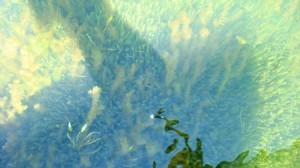
10% Milfoil
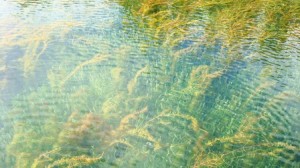
30% Milfoil

50-60% Milfoil
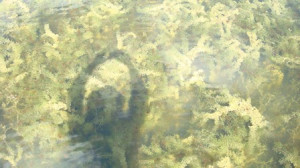
100% Milfoil
River weeds are more than just milfoil
The District, in cooperation with the county weed board and other contributors, maps the presence of Yellow Flag Iris and Flowering Rush; both are relatively new and very detrimental aquatic weeds to the Pend Oreille River. Large scale treatment began for both of these species in 2014 and will continue this summer. For information on what to do if you have either of these plants on your property, please contact Loretta Nichols (lnichold@pendoreille.org) at the Pend Oreille County Noxious Weed Control Board.
For additional information regarding any of the District’s aquatic plant management activities, email the PUD at information@popud.org
